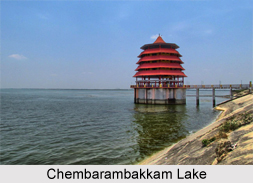 Chembarambakkam Lake is located in the Kanchipuram district in the Indian state of Tamil Nadu. More specifically, Chembarambakkam Lake is located almost 40 kilometers away from the city of Chennai in Tamil Nadu. Characteristically, this lake is a reservoir.
Chembarambakkam Lake is located in the Kanchipuram district in the Indian state of Tamil Nadu. More specifically, Chembarambakkam Lake is located almost 40 kilometers away from the city of Chennai in Tamil Nadu. Characteristically, this lake is a reservoir.
Geography of Chembarambakkam Lake
Globally, Chembarambakkam Lake can be pinpointed at coordinates 13.01158 degrees north and 80.6063 degrees east. Its surface area is about 3,800 acres (15 km2). The complete tank level of the lake is about 85.40 ft (26.03 m). The lake has full capacity of almost 3,645 million ft3 and the level of the tank is about 75.60 ft. The Adyar River originates from this lake and forms its primary outflow. Chembarambakkam Lake is a rain fed reservoir that serves as a source of water for Chennai. Another rain fed reservoir located in the district is the Puzhal Lake.
Chembarambakkam Lake`s water treatment plant has two pipelines connected to it. The pipeline located on Poonamallee Bypass Road holds the capacity to carry only half of the 530 million litres. In the year 2012, the Chennai Metrowater made up plans of setting a third pipeline that would have almost 2000 mm diameter. The budget fixed for the purpose was about 650 million. It would be set from Chembarambakkam water treatment plant and would cover a distance of almost 6.5 km.
Tourism of Chembarambakkam Lake
Tourists visiting Chembarambakkam Lake can also visit an ancient temple dedicated to Lord Shiva, located in the vicinity.
Threat to Chembarambakkam Lake
Chembarambakkam Lake faces threat in terms of adverse effect on its water holding capacity with the passage of time, due to severe sedimentation. More specifically, sedimentation has resulted in almost 40% of the water holding capacity of the lake being destroyed.
This article is a stub. You can enrich by adding more information to it. Send your Write Up to content@indianetzone.com
Related Article:
Lakes of India
Veeranam Lake
Porur Lake















